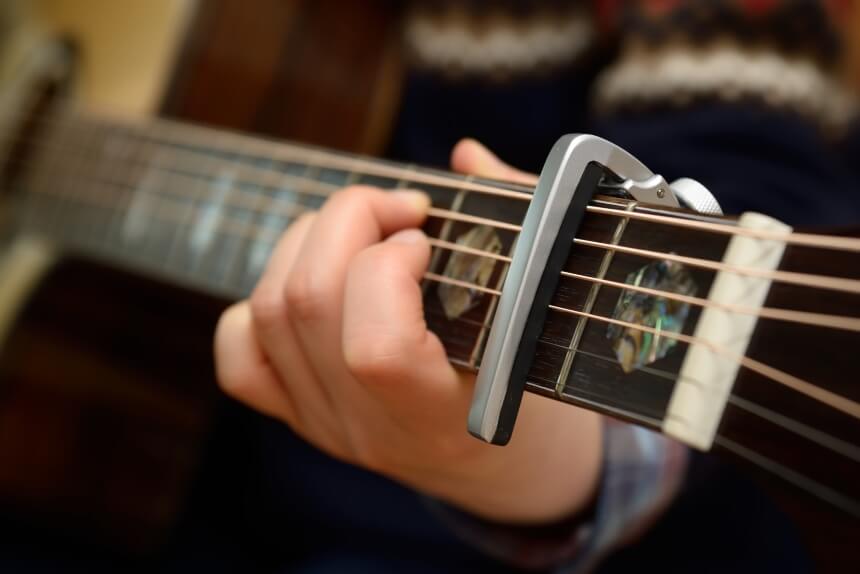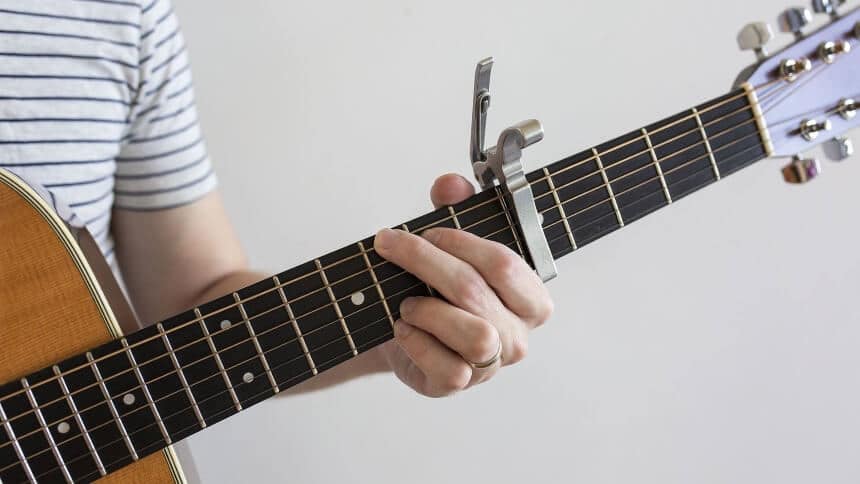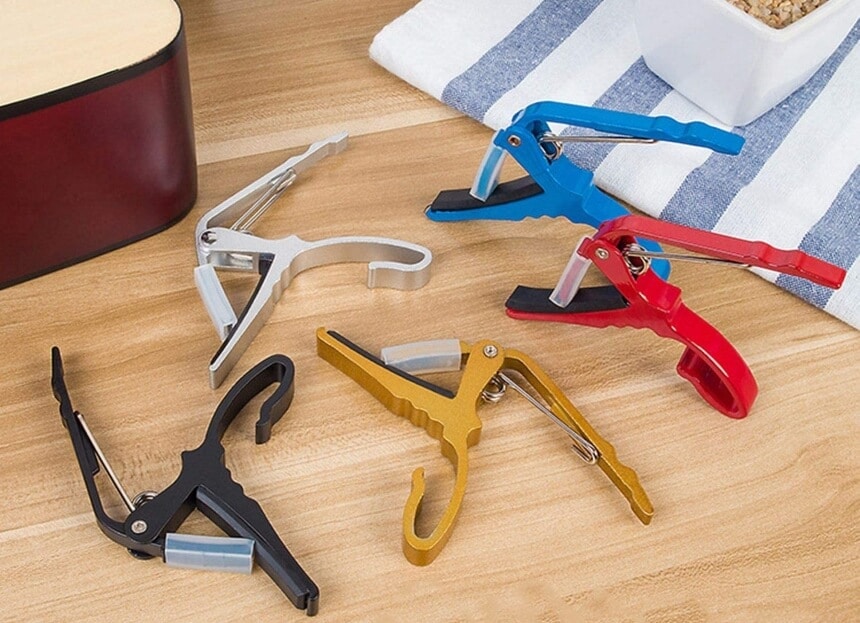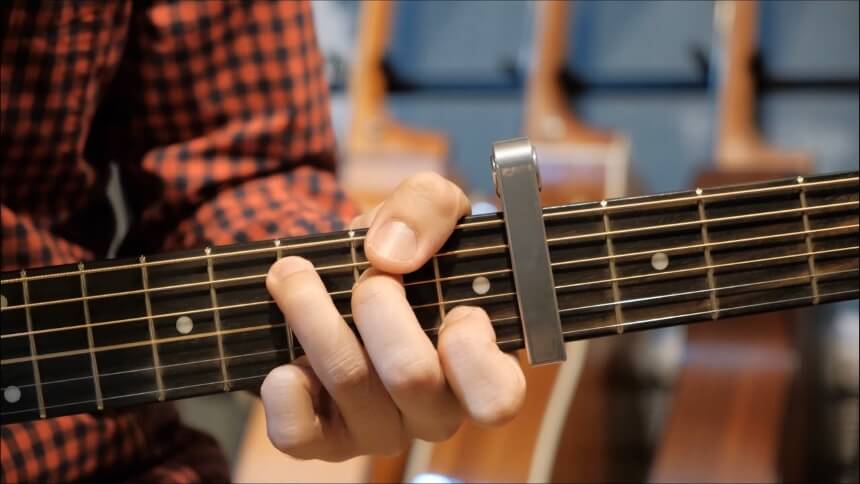If you were to make a list of the must-have accessories for a guitar player, a capo Trusted Source Capo - Wikipedia A capo is a device a musician uses on the neck of a stringed (typically fretted) instrument to transpose and shorten the playable length of the strings-hence raising the pitch. It is a common tool for players of guitars, mandolins, mandolas, banjos, ukuleles and bouzoukis. en.wikipedia.org would come in as one of the essential accessories. While not all guitarists use a capo, a large number do prefer to use the capo. In this post, we will discuss why it is important to use a capo and the various uses to which players put it. We will also talk about how to use a guitar capo.
Whether you are just starting to play the guitar or you are an expert player, you will still find it to be useful. It is not one of those accessories that are designed for beginners. Using a capo depends on the circumstances and what you wish to play.
 To know how to use the capo and whether to use it, you have to know what it is. In the simplest terms, this is a small clamp that you employ to change the position of the nut. This leads to another line of inquiry – what is the nut? The nut of a guitar refers to that small plastic, brass, bone, or other material used to hold the strings together just under the headstock.
To know how to use the capo and whether to use it, you have to know what it is. In the simplest terms, this is a small clamp that you employ to change the position of the nut. This leads to another line of inquiry – what is the nut? The nut of a guitar refers to that small plastic, brass, bone, or other material used to hold the strings together just under the headstock.
One of the most common guitars on the market is the lowest note, especially on a six-string guitar is the 6th string open. Since this is the lowest, it is impossible to go lower. However, you can go higher.
When playing, when you hold the first fret down, you will have the F note instead of the E note you usually get. So, moving the nut refers to holding down the string. When you have the capo, it replaces your fingers and holds the whole strings on the guitar.
With the capo, there is no need to bar several strings. It offers you the ability to hold down the other strings while allowing you to use the other fingers for more important things.
There are several types of capo that you can use right now. In this post, we will consider the different types, their advantages, features, and downsides.
This accessory, as we have said, comes as a clamp. It is a clamp that you use on the fretboard. It comes with a design that allows you to open it and move it to where you want on the board. When close, it will press down all the strings on the guitar.
So, what does it do? In the simplest of terms, the capo raises the key of the guitar.
 Now that we have considered the function of the capo, then it is time to consider some of the reasons why you might use this accessory.
Now that we have considered the function of the capo, then it is time to consider some of the reasons why you might use this accessory.
If you realize what the capo does, the mental picture that you might have is a singer using it with his acoustic guitar. Many people suppose that the capo is only useful in acoustic guitars. However, it is a versatile piece of equipment that can even be used in an electric guitar.
As we have said, whether you are a new player or an old hand, you will find the capo useful. Here are some of the best reasons why you should invest in a capo.
A capo is pretty handy because it lets you transpose very quickly. Imagine, for example, that you are the session player in a band. Perhaps the lead singer does not like the way a certain note sounds as he or she sings, and then they request that you change the key. A capo comes in very handy in such a situation. With this accessory at your disposal, you will find it very easy to transpose to another note or key. You don’t even have to master all the chord voicings before you can do this. Some pretty popular songs down the years have had capos used in this manner.
There are several situations in which players jam together. This is even more common to find in open mic situations and songwriter circles. However, if not careful, it can be chaotic. Imagine if everyone started strumming the exact chords in a similar position. This can cause some issues, so to speak, although some might not mind. However, if you have a capo, you can act to give the playing a better variety and difference as you can play a similar chord at another position. While you can do this with your fingers, using the capo eases the ability to do this.
Playing the same old thing over and over again can get stale fast. If you are looking to spice up your playing and get more out of the regular routine of playing, then a capo can be a good source of inspiration.
Capos are such useful accessories that offer some of the best versatility. You can learn with a capo, and you can also learn without using one. However, most of those we reviewed that started with a capo haven’t stopped using it. It just changes the dynamic of playing for the better.
Some might consider it as cheating, but no matter how good the musician is, you will likely find that he or she uses a capo sometimes.
Although all can use the capo, this accessory is especially excellent for starters. If you are learning to play, it makes it so much easier for you to learn how to play music.
Before we consider how to use the capo, you must know the correct way of fixing it to the guitar. We observe that many users do not fix it correctly, which will affect the way it works. One of the most common mistakes made is that they do not release the handle correctly.
How can you do this correctly?
You can do this by having the capo straight and level before you release the handle of the capo. It might seem like much, but it is actually quite easy to do. All it needs is your patience and care.
 There are several guitar capo styles, and it is important to note them before you start using a capo.
There are several guitar capo styles, and it is important to note them before you start using a capo.
This type of capo acts exactly as is implied by the name. It is attached to the guitar using a strap. Advantages are the ease of use, low cost, and ease of sliding. However, the strap might not be durable and can cause some slipping during use.
This is very similar to the strap capo. However, the difference is that it comes with a toggle for tightening the strap. It is also cheap; however, the toggle can affect the tune of your strings.
 This is one of the most popular types of capo and is the type of capo that we discuss here. It comes with a clamp and release mechanism that you use to hold or release the strings. There are several advantages to using this. For one, it is very easy to use. It firmly holds the guitar strings and offers a higher level of durability. The downside is that inexperienced users often use it wrongly. It can also affect the balance of the guitar if not attached correctly.
This is one of the most popular types of capo and is the type of capo that we discuss here. It comes with a clamp and release mechanism that you use to hold or release the strings. There are several advantages to using this. For one, it is very easy to use. It firmly holds the guitar strings and offers a higher level of durability. The downside is that inexperienced users often use it wrongly. It can also affect the balance of the guitar if not attached correctly.
It is very similar to the Trigger capo. However, the clamp has a more complex mechanism. You can move it with a hand, and it feels quite durable.
These have a screw that can tighten the capo. It applies the pressure from the cent and is opened using a hinge. It is one of the more attractive types of capo.
Are you using sheet music or tabs? If so, it likely shows you instructions to capo a certain fret. So, you should do that. How? Slide the capo to the fret and close it down. How do you know if this is done right? Well, ideally, the capo should hold down all the strings on the guitar. It should be similar to how the strings act when you use your index finger to barre chords.
Another thing that you should keep in mind is how you tighten the capo. Tightening the capo is easy when you know what you are doing.
As with some of the other accessories used in a guitar, there are several ways that you can use the capo. In this post, we will consider several of the ways that you can use the guitar capo.
When you are using the capo, the capo chart comes in very handy. It is a useful option that allows you to slide the capo around and change the keys. If you are a beginner, you will find it super-useful.
Another thing you need to do to get the best use out of the capo is to tune it. If the guitar is out of tune, it will not sound right regardless of where you place the capo. Additionally, it helps that you can play the fundamental open chords before progressing to more sophisticated chords.
Are you playing in a group? If so, you have to know the key that you are supposed to be playing in. Move the capo to change the key and find that which you are comfortable playing.
Without knowing, you might suppose that playing with a capo is something best left to experts. However, even as a beginner, you can learn how to use a guitar capo. Follow the steps and tips in this post to learn the best way to use the guitar capo. If you are looking to purchase a capo, our experts’ recommendation is the WINGO guitar capo that suits both acoustic and electric instruments.